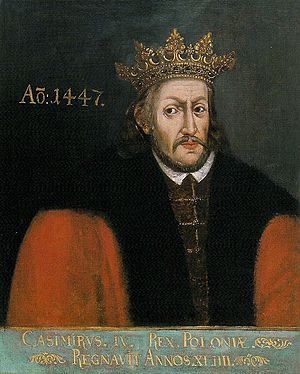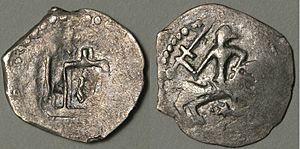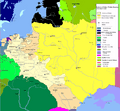Casimir IV Jagiellon facts for kids
Quick facts for kids Casimir IV |
|||||
|---|---|---|---|---|---|

Casimir IV, 17th-century depiction bearing a close resemblance
|
|||||
| Grand Duke of Lithuania | |||||
| Reign | 29 June 1440 – 7 June 1492 | ||||
| Coronation | 29 June 1440 in Vilnius Cathedral | ||||
| Predecessor | Sigismund Kęstutaitis | ||||
| Successor | Alexander I Jagiellon | ||||
| King of Poland | |||||
| Reign | 25 June 1447 – 7 June 1492 | ||||
| Coronation | 25 June 1447 in Wawel Cathedral | ||||
| Predecessor | Władysław III | ||||
| Successor | John I Albert | ||||
| Born | 30 November 1427 Kraków, Poland |
||||
| Died | 7 June 1492 (aged 64) Old Grodno Castle |
||||
| Burial | Wawel Cathedral, Kraków | ||||
| Spouse | Elisabeth of Austria | ||||
| Issue Detail |
|
||||
|
|||||
| Dynasty | Jagiellon | ||||
| Father | Władysław II Jagiełło | ||||
| Mother | Sophia of Halshany | ||||
| Religion | Roman Catholic | ||||
Casimir IV (born Casimir Andrew Jagiellon; 30 November 1427 – 7 June 1492) was a very important ruler in European history. He served as the Grand Duke of Lithuania starting in 1440. Later, he also became the King of Poland in 1447. He ruled both until his death.
Casimir IV was one of Poland's most active kings. During his time, Poland became a major power in Europe. He famously defeated the Teutonic Knights in a long war. This victory helped Poland get back an important region called Pomerania. His family, the Jagiellonian dynasty, grew to be one of the most powerful royal families.
A big success of his rule was bringing Prussia under Polish control. Casimir's time as ruler was part of an era called "new monarchies" in Western Europe. Poland became a key player in international relations. Trade grew, especially for raw materials. This helped crafts and mining across the country. Casimir was also given a special award, the English Order of the Garter. It is the highest honor for knights in England.
After Casimir's death in 1492, his kingdom was split. His son, John I Albert, became King of Poland. Another son, Alexander Jagiellon, became Grand Duke of Lithuania.
Contents
Early Life of Casimir IV
Casimir Jagiellon was the youngest son of King Władysław II Jagiełło. His mother was Sophia of Halshany. Casimir often followed his gut feelings. He was very interested in how his country handled foreign affairs and money.
When Casimir was young, Bishop Zbigniew Oleśnicki was his teacher. However, the bishop didn't think Casimir would be a good king.
Becoming Grand Duke of Lithuania

When Sigismund Kęstutaitis died suddenly, the position of Grand Duchy of Lithuania became empty. Important Lithuanian leaders, like Jonas Goštautas, wanted Casimir to be the next ruler. Many Polish nobles, however, hoped Casimir would only be a stand-in for the Polish King in Lithuania.
Casimir was invited to Lithuania by its leaders. When he arrived in Vilnius in 1440, he was declared Grand Duke of Lithuania. This happened on June 29, 1440. The Lithuanian Council of Lords made this decision. It went against the wishes of the Polish nobles. Jonas Goštautas strongly supported this move.
News of Casimir becoming Grand Duke made Polish leaders angry. Some even threatened war against Lithuania. Since Casimir was young, the Council of Lords, led by Jonas Goštautas, had the main power. Casimir learned the Lithuanian language and customs from court officials.
During Casimir's rule, the rights of Lithuanian nobles became equal to those of Polish nobles. This included dukes, magnates, and lesser nobles. It didn't matter what their religion or background was. Casimir also promised to protect Lithuania's borders. He agreed not to appoint Polish people to Lithuanian government jobs. He also said that big decisions for Lithuania needed the Council of Lords' approval. He gave the region of Samogitia the right to choose its own leader. Casimir was the first Lithuanian ruler to be baptized as a baby. This made him the first native Roman Catholic Grand Duke.
Casimir IV: King of Poland
Casimir became King of Poland on June 25, 1447. He took over after his brother, Władysław III, died in battle in 1444. There was a three-year gap before Casimir became king.
In 1454, Casimir married Elisabeth of Austria. She was the daughter of King Albert II of Germany. Elisabeth was also related to King Casimir III of Poland. Her marriage helped connect the Jagiellon family with the rulers of Hungary and Bohemia.
In the same year, Casimir was asked for help by the Prussian Confederation. This group wanted to fight against the Teutonic Knights. Casimir promised his support. He made the Prussian regions that wanted to be separate a protectorate of Poland. However, when cities rebelled against the Knights, they fought back. This led to the Thirteen Years' War (1454–1466).
After a long and costly war, Casimir and the Prussian Confederation won. In a peace treaty called the Second Peace of Thorn (1466), the Teutonic Knights agreed to Polish rule over western Prussia. This area became known as Royal Prussia. The Knights also recognized the Polish king as their overlord for the rest of their state. This state later became Ducal Prussia.
Elisabeth's only brother, Ladislaus, who was king of Bohemia and Hungary, died in 1457. After this, Casimir and Elisabeth also looked to gain influence in those kingdoms. King Casimir IV died on June 7, 1492. He passed away in the Old Grodno Castle in Lithuania. At that time, Lithuania was in a special union with Poland.
Foreign Relations
Casimir's foreign policy was influenced by events across Europe. The Pope wanted to remove the Hussite King of Bohemia, George Podebrad. This was part of a plan to form an alliance against the Ottoman Turks. Casimir was important to this plan. He used this chance to help his son, Vladislaus II, become King of Bohemia.
However, Casimir did not want to get too involved. His plans were sometimes stopped by Matthias Corvinus, the King of Hungary. Matthias even encouraged the Teutonic Knights to fight against Casimir. Matthias's death in 1490 was a relief for Poland. Casimir spent his last two years making his position even stronger.
In 1490, some Hungarian nobles chose Casimir's son, John Albert, to be King of Hungary. But John Albert was defeated by his older brother, Vladislaus II of Bohemia. Casimir wanted his sons to have their own kingdoms. Most Hungarian nobles preferred Vladislaus. They believed he would respect their freedoms, based on his rule in Bohemia. Vladislaus was crowned King of Hungary on September 18, 1490.
Around 1480, Casimir was allied with the Great Horde. This was against Muscovy and the Crimea. Casimir did not fully support Khan Akhmed at the Great stand on the Ugra River. This played a part in Russia gaining its independence from the nomadic tribes.
Casimir IV's Children
Casimir IV and Elisabeth of Austria had many children who became important figures:
- Vladislaus (born 1456, died 1516); he became King of Hungary and Bohemia.
- Hedwig Jagiellon (born 1457, died 1502); she married George the Rich of Bavaria. Their wedding in 1475 was a huge celebration. It started a tradition that continues today.
- Casimir Jagiellon (born 1458, died 1484); he chose a religious life instead of marriage. He was later recognized as Saint Casimir.
- John I of Poland (born 1459, died 1501); he became King of Poland after his father.
- Alexander I of Poland (born 1461, died 1506); he also became King of Poland later.
- Sophie (born 1464, died 1512); she married Margrave Frederick V of Brandenburg-Ansbach.
- Sigismund I the Old (born 1467, died 1548); he became King of Poland after his brothers.
- Frederick Jagiellon (born 1468, died 1503); he became a Bishop and Archbishop.
- Anna Jagiellon (born 1476, died 1503); she married Bogislaw X, Duke of Pomerania. They had eight children.
- Barbara (born 1478, died 1534); she married Duke Georg dem Bärtigen of Saxony.
- Elizabeth Jagiellon (born 1482, died 1517); she married Frederick II of Legnica.
- Two other daughters also named Elizabeth.
Gallery
-
Casimir IV in his later years, painted by Jan Matejko
-
Giovanni da Capistrano with King Casimir IV
-
Casimir IV's tomb in Wawel Cathedral, a beautiful example of Gothic work by Veit Stoss
Images for kids
-
Lithuanian coin of Grand Duke Casimir IV Jagiellon with the Columns of the Gediminids and Vytis (Pogonia)
See also
 In Spanish: Casimiro IV Jagellón para niños
In Spanish: Casimiro IV Jagellón para niños











